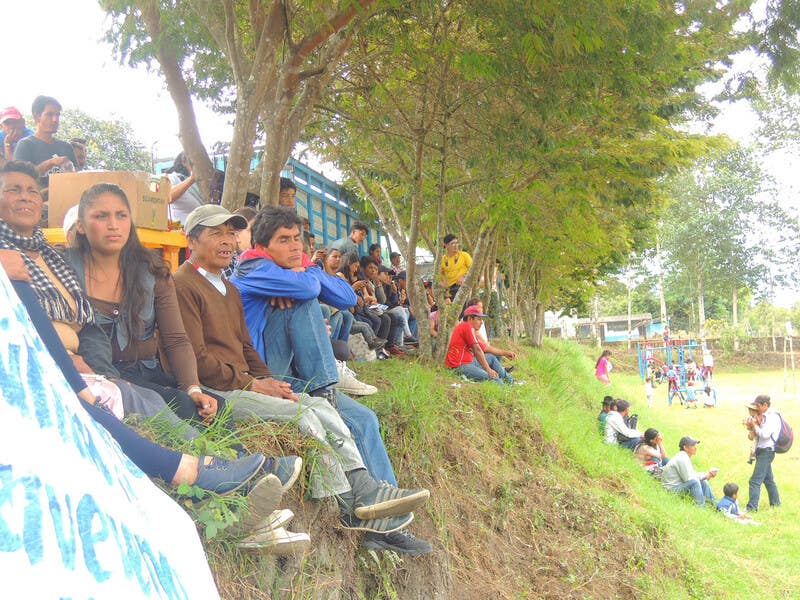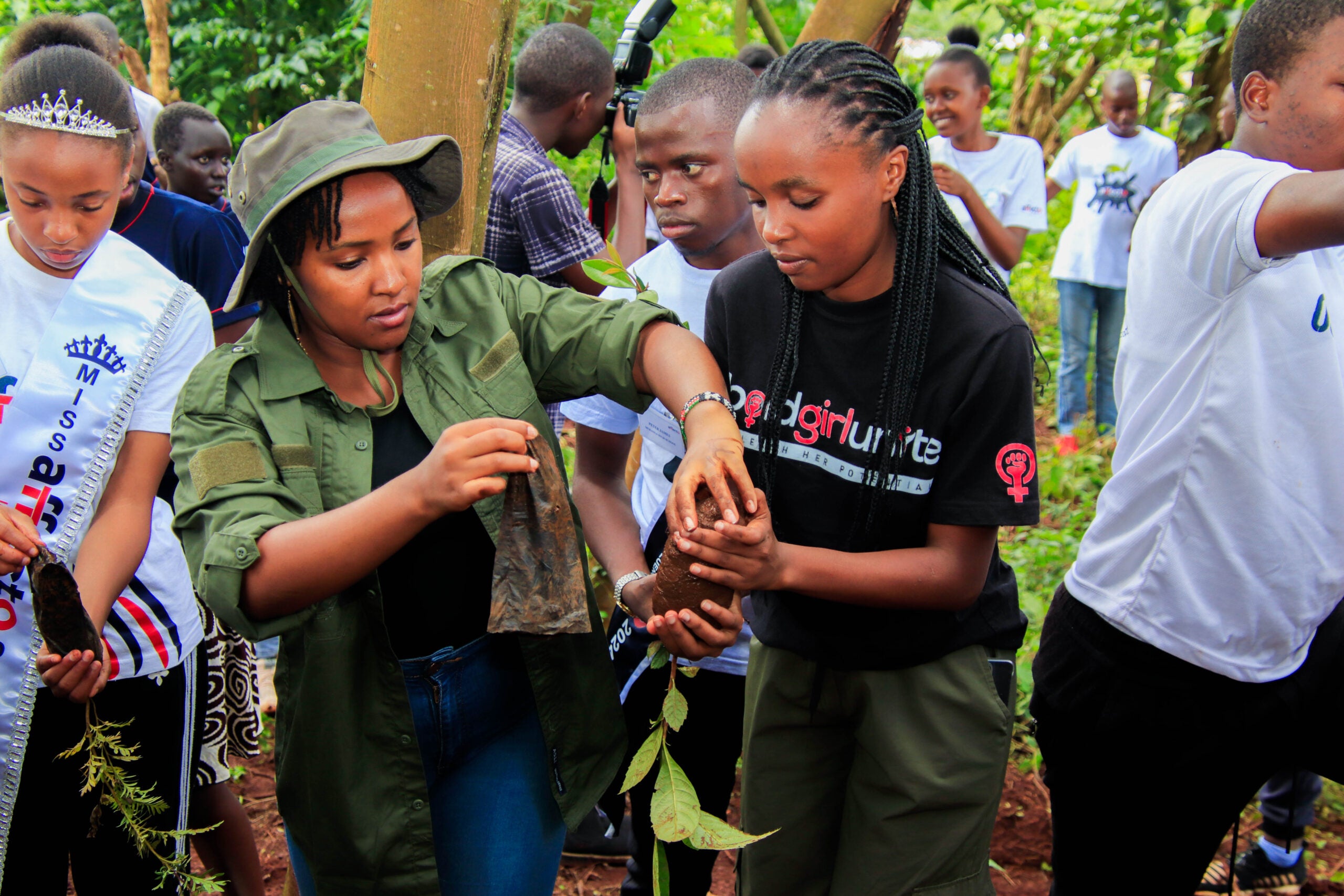One of Cenaida Guachagmira’s most poignant memories is from when she was about 12 years old, in 2006. Her parents and the other adults in their Ecuadorian community of Cerro Pelado had left the younger kids in her care, asking her to cook and feed them, to keep an eye on them, while they went to confront the most recent threat to their lives, their livelihoods, their home, and their powerful connection with nature. A Canadian company, Ascendant Copper Corporation, had received approval from the Ecuadorian government to mine the region for copper, effectively leaving the land barren. She remembers her father coming home beaten up, her brother getting arrested.
Fast forward 15 years and Guachagmira is still fighting the same fight, this time on the frontlines in her parents’ stead, while her two daughters are witness to their mother’s incredible resiliency and spirit of resistance. This time the fight is against the latest in a string of mining companies that, over the last three decades, have received concessions throughout Ecuador’s Intag Valley region, one of the most biodiverse places on the planet.
“At a young age, we learned the value of our parents’ struggle, to teach ourselves the constitutional laws that guarantee our rights, to investigate how we can confront these companies and to know what our rights are so that we can demand them,” Guachagmira says. “We learned to think about the future, and not just for ourselves. I don’t earn a penny doing this and I put my life at risk. I know that. But future generations are worth it. My daughters are worth it.”
Guachagmira is not alone in her tenacious determination and willingness to risk everything to make sure that even some of the most powerful transnational mining companies stay out of the Intag Valley. Since the early 1990s, small towns across Intag Valley’s seven parishes have come together to block roads, overtake mining camps, confront government officials, and demand their constitutional right to resist. Community resistance to mining in Intag Valley is the longest in Ecuador’s history.
And so far, despite a recent loss in an Ecuadorean court and the government approval of mining concessions that cover about 85% of Intag Valley, the communities’ resistance has managed to thwart the full-scale destruction of their land and everything they hold dear, including the diversity of wildlife that shares their home.
“In our community, our relationship with nature it is not so radical,” Guachagmira says. “We live with people of all kinds, of all colors, of all races, but we all share a powerful relationship with the land that feeds us and the animals that live here. We don't produce the Earth. The Earth produces us.”
Organizing for nature
The first time that members of the Junín community of the Cotacachi canton heard about a mining company coming to Intag Valley, they were excited, believing that the project would directly benefit the community, says Javier Ramirez, who has lived in the community since he was born. But that was before the community started to learn about the impacts to nature, which provides them with water, food, their livelihoods, their medicines.
“My family has always lived here. The land gives us everything we need and ensures our survival. We have forest, we have water, we have food. The forest is our life. It’s beautiful,” Ramirez says. “So when we learned about the environmental impact study and the devastating impact it would have on nature, we started to organize throughout the Intag Valley to demand our rights.”
That was in the 1990s, when a Japanese company—a subsidiary of Mitsubishi Corporation—initially planned to mine the area for copper in the first large-scale mining project in the country. At the time the company’s environmental impact assessment estimated that 100 families from four communities would need to be relocated for the mines, and the project would cause so much deforestation that it would result in desertification of cloud forests. Their report also predicted that the water would end up polluted with lead, arsenic, chromium, cadmium, and other toxic substances.
When it became clear that the Ecuadorian government wasn’t going to help prevent such a disaster—or even answer the local communities’ questions about the project—a local organization called Defensa y Conservación Ecológica de Intag (DECOIN) started educating the local communities about the impacts of mining. Local leaders then lobbied the presidents of the seven parish councils. With their support and blessing, they organized sit-ins, marches and demonstrations. But it wasn’t until the communities took matters into their own hands that the government started to pay more attention. “We knew that the company had a lot of staff, but only in the summer,” Ramirez says. “In the winter, only one person staffed their camp. So a crowd of demonstrators from the community went to the camp in the winter and demanded that the mining company representative handed over the key, which he did. After that the company left. It was our first victory in this long fight.”
A second company, this time from Canada, called Mesa, moved in next and similarly was driven out by local opposition. So in 2014, when the world’s largest copper producer, Codelco, joined with Ecuadorean state-owned Enami to develop a huge multinational open-pit copper project in an area called the Llurimagua concession, they brought with them 400 armed members of the military and police.
The deposit that Codelco and Enami EP are planning to mine is estimated to be between 11 and 53 times larger than the deposit identified nearly three decades ago, which would require more families to be relocated to accommodate mining in the Llurimagua concession. However, the ore deposit is estimated to contain only 0.4% copper, which is equivalent to eight pounds of copper for every ton of subsoil. More than 99% of material mined would be waste rock.
In 2014, Ramirez was the president of his parish—and thrown in jail for 10 months for “sabotage and rebellion against the state.” He spent 10 months of an eight-year sentence there after enough public pressure resulted in his early release.
“It was very difficult. I had never left my community, never left my wife, my four children, my mother, my brothers. Never in my family’s history has a family member been imprisoned. It was like in the novels. We could not believe that I was imprisoned without committing a crime, just for being a defender of nature,” Ramirez says. “But even while I was in jail, I knew that I was going to continue to defend nature. The mining companies have not been able to scare me or convince me to stop. I will never stop fighting, my family will never stop fighting, our communities will never stop fighting.”
Weapons versus dignity
In February of this year, both Guachagmira and Ramirez shared their stories as plaintiffs in a case arguing that the mining concessions awarded to Enami and Codelco violate the constitutional rights of four local communities and the rights of nature. The case had been on the docket since 2020, putting a temporary pause on the project. And during that pause, UK and Australian-based BHP Billinton unofficially expressed interest in acquiring the project, while Australian Hancock’s Ecuadorian subsidiary, Hanrine, made an official multimillion dollar offer to do so.
Still, the communities were cautiously optimistic. Just a few months prior, the “Bosque Protector” Los Cedros, which is also in Intag Valley, won an historic victory that determined that mining concessions in that protected forest violated the rights of nature.
But the judge in the Cotacachi canton court ruled that the Llurimagua concession and the planned mining activities did not violate the rights of nature or the communities’ right to consultation about projects that could affect the environment, allowing the companies to continue their work. In addition, the judge requested administrative proceedings against the defense attorneys, in a clear attempt to intimidate the defenders.
In a statement following the oral verdict, several local and regional civil society organizations wrote: “During these ten days…we also witnessed how the state officials and the mining companies’ lawyers treated the scientists, the biologists, and particularly the plaintiffs and the community witnesses with hostility and denigration.”
Since then, the fight has continued. On March 3, the community of Cerrado Pelado came together to form a human chain on a narrow road to prevent three vans carrying employees from Codelco and officials from the Ecuadorean Ministry of the Environment from passing.
“We waited there just like we always do, ready for whatever happens,” says Guachagmira. “We told them ‘You know what? You can’t get in and you’re not going to get in. You can come with policemen, with mayors, with presidents, but you are not going to pass because we are not going to let you pass.”
Two days later, on March 5, dozens of community members from different parts of Intag confronted BHP in the community of Cazarpamba so that they would not enter their community to publicize their plan to work in the area. After the confrontation, a BHP representative allegedly said that the company would not return to the Intag Valley.
On March 16, lawyers for the local communities filed an appeal in the Cotacachi canton court, hoping for another opportunity to make their case in the Superior Court of Imbabura.
And no matter what happens, the local communities will never give up, Guachagmira and Ramirez agree.
“The companies have their weapons and we have our dignity,” Guachagmira says. “We fight with the constitution, the truth and with our conviction. We are not fighting only for ourselves, but for all life on the planet. I invite the world to join us, and not just us, but all of the little towns everywhere that are fighting for you, for me, for a healthy planet.”
Luis Fernando Marin da Fonte assisted with interview translation for this post
Subscribe to Re:wild’s newsletter and follow along on social media [Facebook, Twitter, Instagram] for updates on this case
Lindsay is the Director of Media Relations for Re:wild and has a particular interest in leveraging communications to inspire conservation action. Lindsay is passionate about species-based conservation and finding compelling ways to tell stories that demonstrate the value of all of the planet’s critters, big and microscopic.




